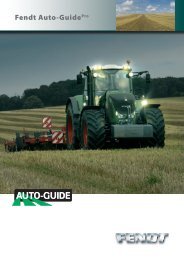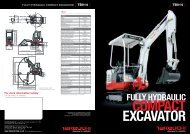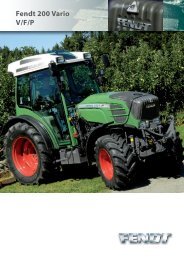You also want an ePaper? Increase the reach of your titles
YUMPU automatically turns print PDFs into web optimized ePapers that Google loves.
Igloo shelter for the fi rst few<br />
weeks<br />
The immune system of calves takes<br />
three to four months to develop completely.<br />
Only then can a calf protect<br />
itself independently from invasive<br />
germs. The fi rst few weeks are crucial.<br />
So how best can we protect calves<br />
from these germs?<br />
Fresh air and a clean<br />
environment<br />
Dangerous germs are airborne and<br />
also arise through direct contact with<br />
other calves. It is important to break<br />
this cycle of infestation. The rule is:<br />
The less contact with other calves<br />
and the fresher the air the better.<br />
So the best way of rearing a calf<br />
in the early weeks is to keep it in an<br />
Igloo. The calves can be reared separately<br />
and preferably outside the<br />
cowshed, out of doors. There are two<br />
main considerations: the calves must<br />
not get wet and must not suffer from<br />
www.siloking.com<br />
Comfortable cows ar<br />
The fi rst few weeks are crucial<br />
The longer the calves are housed in<br />
igloos, the better their resistance to<br />
infection<br />
Comparison: heated stall and igloo, days 1-42<br />
(Davis, C.L. a. Drackley, L.K., 2000)<br />
Heated stall Igloo<br />
Dairy exchanger 20,3 kg 20,8 kg<br />
Calf rearing feed 28,3 kg 40,0 kg<br />
Daily weight increase 340 g 509 g<br />
Digestion of feed 0,36 0,45<br />
Diarrhoea<br />
(1=normal consistency, 2=liquid) 1,23 1,07<br />
Treatments 19,2 2,9<br />
draughts when lying down. So cold<br />
air is an advantage (less germs) and<br />
does not trouble the calves; high temperatures<br />
in the Igloo are to be avoided.<br />
This has all been confi rmed by<br />
research.<br />
In the research results it was clear<br />
that in the groups investigated out of<br />
24 calves, those needing treatment<br />
dropped from 19 to just 3. Needles to<br />
say, better health means a better appetite<br />
and better digestion and higher<br />
daily weight gain.<br />
Air, light and water<br />
Separate dry conditions with fresh<br />
air provide the best environment for<br />
healthy calves. The shape and characteristics<br />
of the igloo are very important.<br />
White igloos refl ect the sun and<br />
prevent additional heat build-up inside.<br />
The inside should be designed to<br />
allow the free circulation of air without<br />
the need for additional openings and<br />
so that condensation cannot drip on<br />
the animals. Calves need milk but it is<br />
important to provide them with water<br />
too from the start. From week 2 calf<br />
rearing feed and hay should be added.<br />
With its bucket holder and hay rack<br />
the FLIXBOX is well equipped.<br />
An open air run allows the calf to<br />
enjoy the outdoors (e.g. fresh morning<br />
air) and benefi t from the positive<br />
effects of direct sunlight (UV).<br />
The preferred igloo material is GRP<br />
(glass reinforced plastic). It is more<br />
stable than the cheaper polyethylene<br />
and is UV resistant with a long service<br />
life (polyethylene becomes brittle and<br />
cracks in sunlight).<br />
Interesting benefi ts in effi ciency<br />
It is true that calves kept individually<br />
take up more of your time than those<br />
kept together as a group, but don’t<br />
forget that sick calves kept together<br />
are more work than healthy calves in<br />
The FLIXBOX multi-occupancy igloo is designed for seven calves. A convenient<br />
door allows easy access and regular checking of the calves All the calves can<br />
be dealt with at the same time with the metal fencing.










